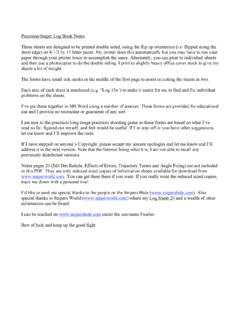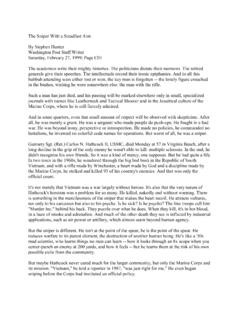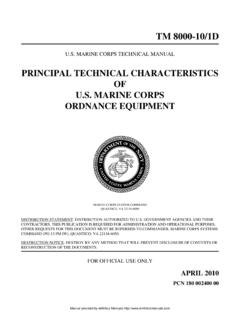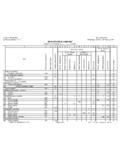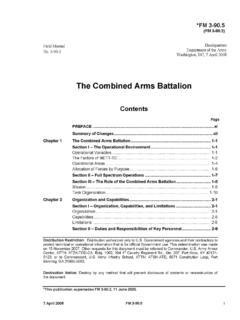Transcription of Bedding Your Tikka T3 - SNIPER GEAR
1 Bedding your Tikka T3. By Scott Broder Coeur d'Alene, Idaho, USA. Frequently Asked Questions: 1. What is pillar Bedding vs glass Bedding ? Most actions have (2) action screws that go through the stock from the bottom and screw up into the action pulling the action down onto the stock. Pillar Bedding is when aluminum or steel tubes ( pillars') are inserted into the existing holes in the stock where the action screws go. New action screws are used that match the tubes. Pillar Bedding allows for better contact between the action and the stock, and allows more precise torque setting on the action screws. Glass Bedding in an epoxy compound is put on the stock that gets sandwiched in between the stock and the action. This provides a 100% surface area contact between the action and stock.
2 Without glass Bedding , the only contact between the action and stock would be few contact points where they action happens to rest or mate to the stock. Glass Bedding can be done in conjunction with pillar Bedding . Note that on a T3, the recoil lug just sits in a slot milled in the stock. On a Tikka T3, glass betting locks the recoil lug into place, preventing it from moving over time. This is very important on a T3, and can affect the accuracy on many of the T3 rifles as the barreled action recoils against this lug sandwiched in the stock. 2. On a Tikka t3, do I pillar bed or glass bed? Short answer is you do both. They both improve accuracy but in different ways. Pillar Bedding is easier and cleaner to do if you want to try this first. Pillar Bedding serves to reduce compressive stress onto the stock from overtightening the screws.
3 It also ensure perfect action to floorplate or DBM spacing (for reliable magazine function). 3. What Bedding compound should I use? Short answer is Devcon #10110. Search the web and you will find people use lots of different compounds. Lots of them are good, some are better than others. I use Devcon 10110 because: Devcon sets harder than some of the others, which I like, Devcon is proven not to shrink over time, Devcon has the consistency of peanut butter so it doesn't drip when working it in. I bought a 1 lbs can and was able to do 3 or 4 stocks. 4. What release compound should I use? Short answer is Kiwi Neutral Shoe Polish. Again, search the web and you will find people use lots of different compounds. Lots of them are good, some are better than others.
4 I use Kiwi Neutral Shoe Polish because: Kiwi works, Kiwi is cheap. Note that you need Neutral otherwise you will stain your stock. 5. Should the barrel free float or do I bed the entire length? I recommend ensuring your barrel is free floated completely. Some folks say 1" around the lug area (including in front). I recommend as in the picture (including in front of the dotted red line). Even with sporter weight barrels, that extra bit of support makes a difference and takes a bit of strain off the action screws in my view. I don't find that the barrel chamber/. taper gets real hot, so it doesn't need to be free floated in my view. However, you want to make sure the rest of your barrel is floating. If not, just use a half-round rasp to clean up your barrel channel if need be.
5 Whilst doing this, have a good look at the inlettting around the action to ensure everything looks right. 6. How does the action fit in after the Bedding ? The whole barreled action should just sit right down easily without force into the stock inlet. You need to wobble the barreled-action back and forth a little to get the recoil lug to snap into the slot of the action - especially with aftermarket lugs which can be slightly thicker. If you cannot screw in the front action screw, or if there is a large gap between the front of your barrel channel and barrel, it means the lug isn't sitting into the mating slot of the action properly (easy to do and not notice with Tikka T3s). 7. How do I tighten the action to the stock while Bedding is drying? Use surgical tubing (or electrical tape) around the action.
6 Tighten whatever you use around the action by the ejection port. Do not just wrap tape around the barrel and forearm. This will press the barrel into the forearm and not allow the barrel to free float. Forster also sell various sets of stockmaker's and inletting guide screws including in the M6 x 1mm thread to suit the Tikka T3. The guide screws are useful for ensuring the pillars line up with the action holes of the stock. The stock maker's screws go a step further and index the pillar inline with the action hole due to their conical head, as well as secure everything together during Bedding . Some argue the stockmaker's screws exert too much pressure when glass Bedding causing the action to flex somewhat if left in place. The Tikka action is pretty rigid with a very small ejection port.
7 I use tubing for holding the action into place during the Bedding but these Bedding screws (pictured) are useful for getting everything sitting firmly in place to start off and I. believe on the Tikka action they can be left in place as long as they are no overtightened. Be sure to put plenty of release compound on the threads and stem. Forster Inletting guide screws (M6 x 1 thread) Forster stockmaker's screws (M6 x 1 thread). (Brownells #:319-415-270WB) (Midway USA #: 134179). 8. Do I tighten the action screws if I do not have the stockmaker's screws, while the Bedding is drying? You can. However do not tighten them too much. I just tighten them by hand to what feels tight enough to make sure the action is in place - no more. I don't have a specific tightness I.
8 Torque when waiting for the Bedding to cure I do it by feel. It is important to be able to get them out again. I first push the action in as hard as possible, then tightening just gets it firm and locked in for the curing. You need to make sure the barrel is sitting down where it should. Make sure there are no gaps where the tape is. Make sure you apply plenty of release agent to the action screws and action screw holes. When you insert the screws to tighten the action into the bedded stock, Bedding compound will find its way into the pillars as well as all the screw threads. This isn't a problem as long as you have applied liberally the agent into the threads. 9. How do I keep the barrel centered in the stock and at the correct height while compound dries?
9 Around a single point on the barrel, wrap several layers of electrical tape until it is a tight fit between the barrel channel in the stock. This way, when you lay the action onto the stock during drying, the barrel will center itself in the forend, and wont sink into the barrel channel. This also makes sure the barrel floats afterwards. Wrap the tape approximately 2 inches back from the forearm. Don't wrap too much tape or the barrel will sit too high. The barrel should fit in snug but not tight. It should need to be press in, but lightly, not need to be forced in. BEFORE you glass bed, test this a few times, by wrapping tape and tightening the action screws to the proper torque settings a few times to make sure it all fits together that way it should.
10 Unwrap little bits of the tape as necessary until the barrel is spaced against all sides of the channel equally ( both sides as well as bottom). 10. How do I clean and trim the excess? I clean up the excess Bedding compound that squeezes out the sides of the action / barrel channel and under the bottom metal with lots of little damp / wet pieces of cloth (prepare before you start). I also have those ice cream sticks to clean away the bigger bits. Make sure you also have a small Xacto knife ready. Make sure BEFORE you bed, to apply the release compound to the areas on the stock around the action and tang area to its easier to clean later. Another option is to tape all the bits of the stock up beforehand, but I don't like this method as I have found it is easier to clean the excess priot to it setting (including on tape).
